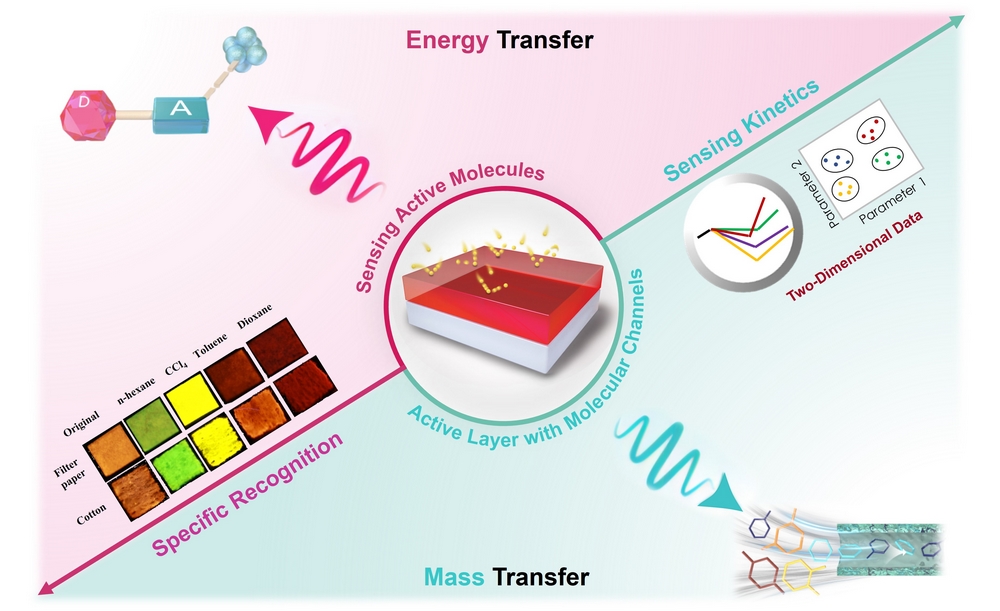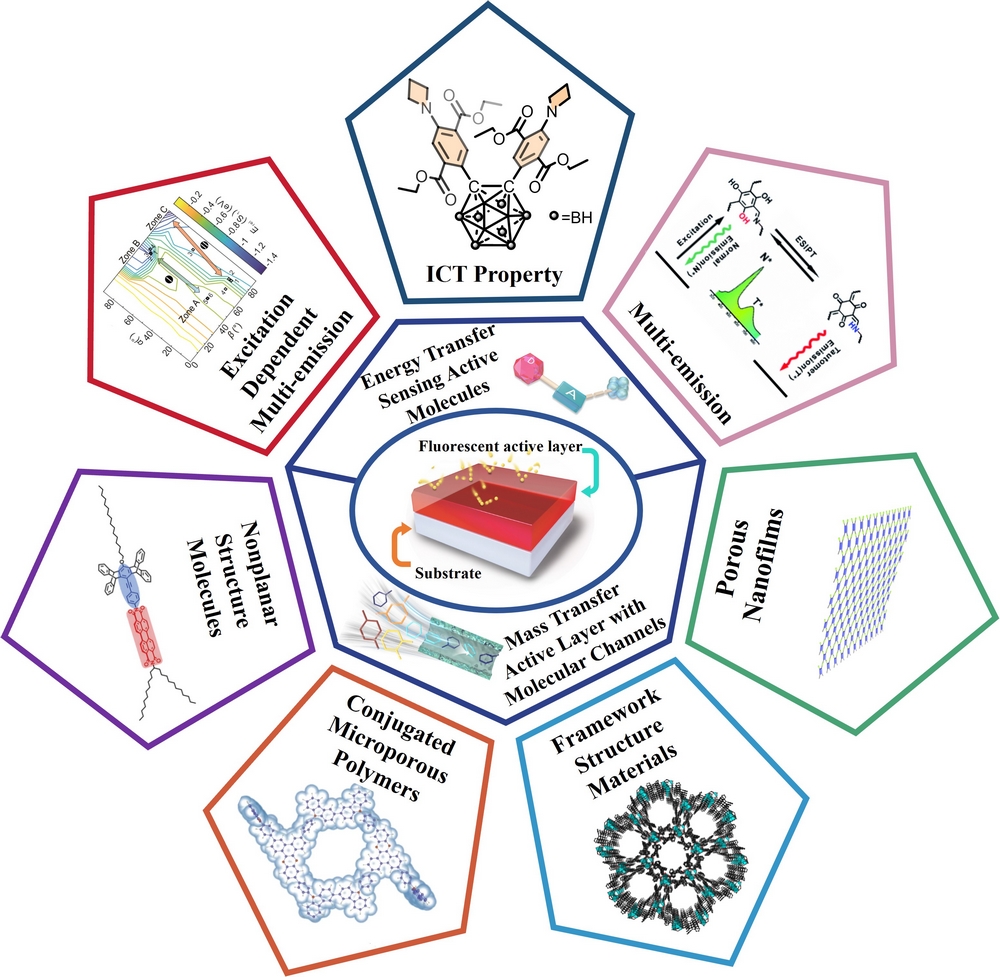
Haonan Peng, Liping Ding*, and Yu Fang*. J. Phys. Chem. Lett., 2024, 15, 849-862.
JPCL Perspective: Recent Advances in Construction Strategies for Fluorescence Sensing Films
Recently, Prof. Yu Fang’s research group published a review on the latest advancements in fluorescent sensing film construction strategies in JPC Letters. Prof. Peng Haonan is the first author, and Prof. Fang Yu and Prof. Ding Liping are the correspondence authors.
Background
A year ago, film-based fluorescent sensors (FFSs) were recognized in the “IUPAC Top Ten Emerging Technologies in Chemistry 2022” due to their extensive application in detecting hidden explosives, illicit drugs, and volatile organic compounds.
The active sensing layer primarily consists of fluorescent compounds, supported by a solid substrate. Film-based fluorescence sensing entails intricate interfacial interactions, which can generally be categorized into two fundamental processes: “energy transfer” and “mass transfer” (Fig 1). Among these, the “energy transfer” process pertains to the interactions between the sensing unit and the analyte molecule. These interactions impact the energy transformation within the luminescence process of the sensing unit, leading to alterations in fluorescence intensity, lifetime, and emission wavelength. While the “mass transfer” involves the adsorption, diffusion, and desorption of analyte molecules within the active layer. The efficacy of the sensing film is primarily reliant on the sensing mechanism and the structural composition of the sensing unit within the active layer.

Fig. 1 Scheme of the basic process of film-based fluorescence sensing
Overview
Recently, Prof. Yu Fang published a review on the latest advancements in fluorescent sensing film construction strategies in JPC Letters. This review focuses on the latest developments in the construction strategies of fluorescent sensing films. Firstly, we summarize innovative design strategies for obtaining sensing active molecules that enhance “energy transfer” between fluorophores and analyte molecules. We have a distinct emphasis on a range of methodologies, encompassing the acquisition of molecules exhibiting intramolecular charge transfer (ICT) characteristics, solitary molecules demonstrating multiple emission profiles, and single molecules displaying excitation-dependent multi-emission behaviors. These strategies facilitate the tracking of analytes devoid of photoelectric reactivity or reliant on specific recognition moieties. Secondly, we outline the latest developments in constructing active layers with molecular channels to enhance “mass transfer” during the sensing process. Advanced materials such as nonplanar-structured molecules, conjugated microporous polymers, framework-structured materials, and porous nanofilms are employed to fabricate active layers with porous structures.
In addition to the aforementioned fabrication strategies, the recent integration of finite element simulation and microfabrication technologies has emerged as a systematic approach to modulate the surface morphology and microstructure of the substrate in sensing films. These techniques provide the physical means to implement these designs with high precision structured at the micro and nanoscale. 85-87 This may become a highly effective method to enhance the performance of film-based fluorescent sensors.

Fig. 2 Recent advancements in novel construction strategies for fluorescent sensing films
Challenges and Opportunities
While significant progress has been achieved in the construction and application of FFSs, several challenges and opportunities remain to be addressed in this field. Firstly, there is a need for a deeper understanding of the exact mass transfer mechanisms involved in film sensing. Prevailing diffusion models, such as Knudsen diffusion and molecular diffusion theories, focus mainly on the physical characteristics of analyte molecules, such as gas constant and molecular weight, while overlooking the chemical properties of the molecules. In reality, the molecular interactions between analytes and the fluorescent active layer play a crucial role in influencing the mass transport process. Therefore, further research is required to elucidate the intricate interplay between molecular interactions in film-based fluorescent sensors. Secondly, comprehensive investigations are urgently needed to gain profound insights into the development of superior sensing films. This entails the synthesis of novel sensing molecules and the construction of active layers with well-defined molecular channels. These aspects form the foundation for the preparation and application of FFSs. In-depth studies in these areas will enable the design and fabrication of advanced sensing films with enhanced performance and sensitivity. Lastly, the design and integration of robust environmental sensors pose a major challenge. Real samples containing target analytes in complex mixtures can be prone to interference from other compounds, thereby affecting the accuracy and selectivity of the sensing process. Consequently, the development of grid environmental sensors with high selectivity is an emerging approach that requires dedicated efforts and attention.
The relevant paper was published in JPC Letters, with Professor Haonan Peng as the first author, and Professors Liping Ding and Yu Fang as the corresponding authors.
Article Information: J. Phys. Chem. Lett. 2024, 15, XXX, 849–862
Correspondence Authors: Prof. Fang Yu, Prof. Ding Liping, Shaanxi Normal University
First Author: Prof. Peng Haonan, Shaanxi Normal University
Publication Date: January 18, 2024
Full Text Link: https://doi.org/10.1021/acs.jpclett.3c03130
 Latest Updates
Latest Updates






